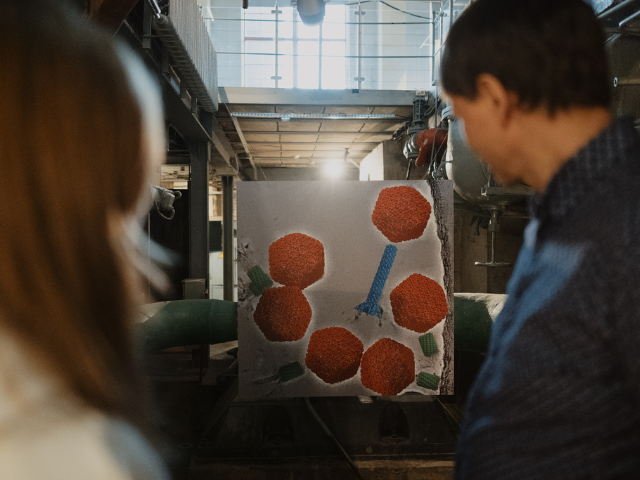Have you ever wondered what lies beyond the limits of the naked eye? The unique exhibition "Explore and Create: Where Science Becomes Art" hosted at the Energy and Technology Museum and organized by the European Molecular Biology Laboratory (EMBL) and the Life Sciences Center of Vilnius University (VU) offers a fascinating glimpse into the microscopic world and reveals how science and art can merge to open the door to a whole new understanding of the world.
"This exhibition is more than just a dialogue between science and art. It marks a significant milestone: the 50th anniversary of the EMBL and five years of Lithuania’s membership in this organization," said Virginijus Šikšnys, Distinguished Professor at the VU Life Sciences Center and one of the event organizers.
A unique blend of science and art
The exhibition unfolds in two captivating parts. The first one features the works of young creators, Lithuanian pupils, who took part in the international EMBL competition "Unfold Your World". Inspired by proteins – the molecular world often confined to scientific laboratories – pupils unleashed their imagination and personal interpretations to transform science into artworks.
"This was the first time the competition has been held in Lithuania, attracting 12 schools and over 40 submissions. Three works were recognised as winners in the international competition, which featured more than 150 artworks from around the globe. The project introduced pupils to science and fostered creativity, critical thinking, and a new perspective on viewing science as a source of art and inspiration," remarked Dr. Paulius Lukas Tamošiūnas, Head of the Methodological STEAM Education Centre and co-organiser of the exhibition.
The second part of the exhibition focuses on high-resolution microscopy images by scientists from the EMBL and the VU Life Sciences Center, revealing the beauty of viruses, organelles, cells, and even the intricacies of the brain of mice. These images are not just scientific data; they resemble abstract artworks that captivate the eye and invite visitors to admire the complexity of the world through their colours and structures.
"The exhibition showcases works by pupils alongside scientific images produced by professionals, creating a symbolic interaction between youthful curiosity and mature scientific discoveries. This interplay invites visitors to "get closer to science" – both literally, by exploring the microscopic images, and metaphorically, through artistic interpretation," noted Monika Šimoliūnienė, co-organiser and researcher at the VU Life Sciences Center.
The significance of this exhibition lies in its power to bridge seemingly unrelated worlds and demonstrate that science is more than just numbers and formulas – it can also inspire new ways of understanding the reality around us.
A captivating lecture on the world of proteins
The opening of the exhibition featured an inspiring lecture by Dr. Giedrė Tamulaitienė, "The Story of Proteins: From Molecular Beauty to Their Functions". The scientist explained the importance of proteins to life, their complex structure and functions, and how they can inspire art.
One of the most outstanding examples is the sculpture "Angel of the West", inspired by the structure of antibodies – key molecules of the human immune system. It illustrates how science and art complement each other, deepening our understanding of the human body and environment.
The exhibition "Explore and Create: Where Science Becomes Art" is an opportunity to pause and see the world from a new perspective. It encourages visitors to discover the connection between what we see every day and what remains invisible but is still invaluable to our lives.
The exhibition runs until March 7 at the Energy and Technology Museum in Vilnius. It is not only a scientific exhibition – it is also an emotional experience. Don’t miss this unique opportunity to explore the hidden beauty of the world and witness how science can inspire art.
Come and explore!
Designer: Erikas Druskinas. Partners: Vilnius University, EMBL, STEAM centres, Energy and Technology Museum. Sponsors: Thermo Fisher Scientific, Linea Libera, Future Biomedicine Foundation.
 |
